“Skeletouch: Transparent Electro-Tactile Display for Mobile Surfaces”
Conference:
Experience Type(s):
Title:
- Skeletouch: Transparent Electro-Tactile Display for Mobile Surfaces
Description:
An electro-tactile display is a possible candidate for a truly tangible multi-touch interface for four reasons. First, it only requires an electrode substrate that can be made transparent and thin. Second, it has a potential to present high-resolution tactile information of 3mm or less, which is preferable for shape presentation. Third, it’s principle is active so that it does not require user’s finger motion. Fourth, the electrical stimulation can be innately used for multi-touch sensing. This paper introduces a prototype transparent electro-tactile display mounted on mobile devices.
References:
[1]
Bau, O., Poupyrev, I., Israr, A., and Harrison, C. 2010. Teslatouch: Electrovibration for touch surfaces. In UIST ’10 Proceedings of the 23nd annual ACM symposium on User interface software and technology, 283–292.
[2]
Baudisch, P., and Chu, G. 2009. Back-of-device interaction allows creating very small touch devices. In 27th international conference on Human factors in computing systems, 1923–1932.
[3]
Collins, C. C. 1970. Tactile television: Mechanical electrical image projection. IEEE Transaction on Man-Machine System 11, 1, 65–71.
[4]
Fukumoto, M., and Sugimura, T. 2001. Active click; tactile feedback for touch panels. In CHI ’01 extended abstracts on Human factors in computing systems, 121–122.
[5]
Kaczmarek, K. A., Nammi, K., Agarwal, A. K., Tyler, M. E., Hasse, S. J., and Beebe, D. J. 2006. Polarity effect in electrovibration for tactile display. IEEE Transaction on Biomedical Engineering 53, 10, 2047–54.
[6]
Kajimoto, H. 2012. Design of cylindrical whole-hand haptic interface using electrocutaneous display. In Proceedings of the 2012 EuroHaptics, 67–72.
[7]
Kajimoto, H. 2012. Electro-tactile display with real-time impedance feedback using pulse width modulation. IEEE Transaction on Haptics 5, 2, 184–188.
[8]
Kajimoto, H., 2012. Transparent electrodes for electro-tactile display. Conference Abstract of Haptics Symposium, March.
[9]
Nara, T., Takasaki, M., Maeda, T., Higuchi, T., Ando, S., and Tachi, S. 2001. Surface acoustic wave tactile display. IEEE Computer Graphics and Applications 21, 6, 56–63.
[10]
Poupyrev, I., and Maruyama, S. 2003. Tactile interfaces for small touch screens. In Proceedings of the 16th annual ACM symposium on User interface software and technology, 217–220.
[11]
Tachi, S., Tanie, K., Komoriya, K., and Abe, M. 1985. Electrocutaneous communication in a guide dog robot (meldog). IEEE Transaction on Biomedical Engineering 32, 7, 461–469.
[12]
Weinstein, S. 1968. The skin senses. Charles C. Thomas Publisher, ch. Intensive and extensive aspects of tactile sensitivity as a function of body part, sex and laterality, 195–222.
[13]
Winfield, L., Glassmire, J., Colgate, J. E., and Peshkin, M. 2007. T-pad: Tactile pattern display through variable friction reduction. In Second Joint EuroHaptics Conference and Symposium on Haptic Interfaces for Virtual Environment and Teleoperator Systems (WHC’07), 421–426.
[14]
Bach y Rita, P. B., Kaczmarek, K. A., Mitchell, T. E., and Garcia-Lara, J. 1998. Form perception with a 49-point electrotactile stimulus array on the tongue. Journal of Rehabilitation Research Development 35, 427–430.





